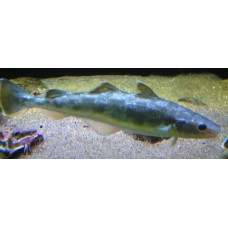Latin name
Eleginus gracilis
Other names
Wachna cod, Pacific navaga.
Identification
The lower jaw is shorter than the upper jaw, there is a chin tendril whose length does not exceed half the diameter of the eye. The distance between the second and third dorsal fins is equal to or greater than the diameter of the eye. The lateral line is curved forward and ends below the second dorsal fin. Head without lateral line pores. Paraphyses expanded, swollen and hollow, beginning at about the centre of the 9th or 10th vertebra, containing protrusions of the swim bladder. Second pelvic ray formed. Caudal end truncated or slightly pointed.
Features of fish fins
Dorsal spines (total): 0; Dorsal soft rays (total): 44-59; Anal spines: 0; Anal soft rays: 39-47; Vertebrae: 57-64. Distinguished by the presence of 3 dorsal and 2 anal soft rays.
Fish colouring
Upper part grayish brown, upper part of sides paler, sometimes with a silvery-violet tinge, often flecked with faint dark spots. Underside and belly yellowish to silvery white. Fins are dark, dorsal and caudal with white edges.
Distribution
It inhabits the coastal areas of the Sea of Japan, the Sea of Okhotsk, the Bering Sea and the Chukchi Sea.
Habitat
Cold-loving benthic fish. Found in shallow coastal waters. Enters rivers and can travel considerable distances upstream, but usually remains within the tidal influence zone.
Size
Maximum length is 55 cm, usually 25-35 cm, body mass up to 1.3 kg. Maximum reported age: 15 years.
Behavior
Its feeding period takes place in summer at depths of 30-60 metres. In the autumn-winter period, schools of fish move to the shores to breed. Some shoals even enter lakes and estuaries.
Food and feeding habits
It feeds on a variety of worms, crustaceans, eggs and young of other fish.
Reproduction
Matures in the second or third year of life. Spawns in January-March at bottom water temperatures of -0.5 to -1.9°C. The female lays 4.9-680 thousand eggs, which adhere lightly to underwater objects. As the juveniles grow, they become more visible to predators and sometimes have to seek refuge under the dome of the jellyfish Cyaneas and Aurelias.
Fishing
It is a valuable commercial fish, and under-ice recreational fishing is also common.
Relationship with a person
In late autumn and winter, saffron cod tastes good, which is not the case with spring and summer fish.
| Classification | |
| Phylum | Chordata |
| Class | Actinopterygii |
| Squad | Gadiformes |
| Family | Gadidae |
| Genus | Eleginus |
| Species | E. gracilis |
| Features | |
| Conservation status | No information |
| Habitat | Bottom |
| Life span, years | 15 |
| Maximum body weight, kg | 1,3 |
| Maximum length, cm | 35 |
| Sailing speed, m/s | No information |
| Threat to people | Edible |
| Way of eating | Predator |
Saffron cod
Tags: saffron cod


